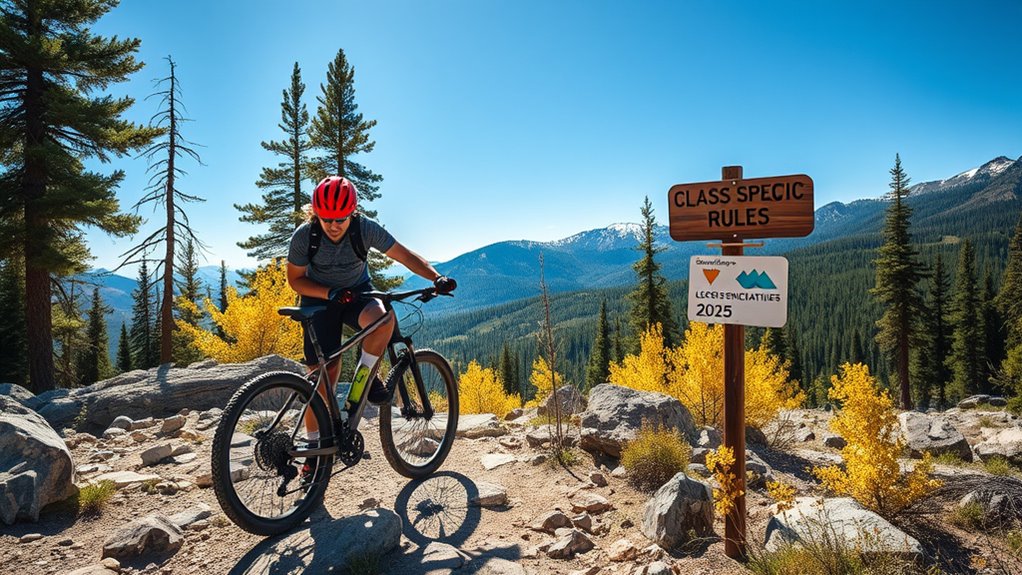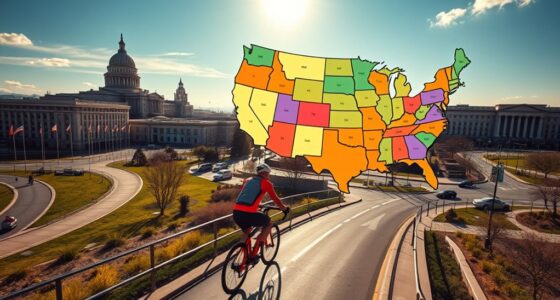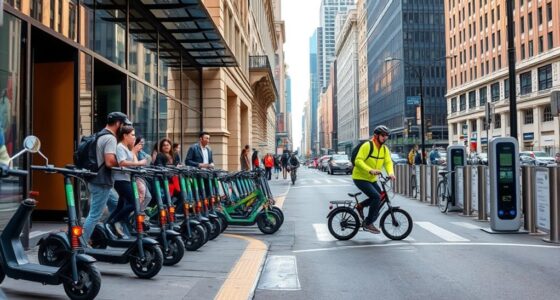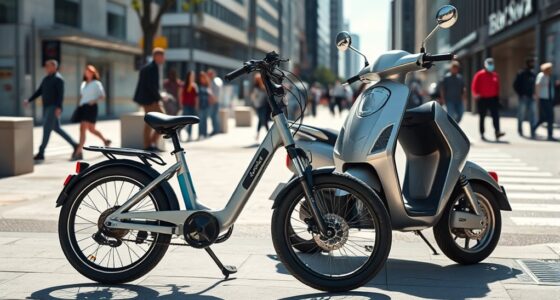In Colorado, you need to know your e-bike class to ride legally and safely. Class 1 and 2 bikes are generally allowed on most roads and bike paths, while Class 3 bikes have more restrictions and often aren’t permitted on certain trails. Always check trail signage for access rules and restrictions to avoid conflicts. Staying aware of local regulations, signage, and riding responsibly helps you enjoy Colorado’s outdoors safely. Continuing will give you detailed tips for smooth riding across the state.
Key Takeaways
- Colorado classifies e-bikes into three categories: Class 1, 2, and 3, each with specific speed and assistance limits.
- Class 1 and 2 e-bikes are generally allowed on most roads and bike paths, while Class 3 has additional restrictions.
- Trail access for e-bikes depends on signage; they are prohibited where trails are marked restricted or closed.
- Riders must adhere to local regulations, including helmet use and speed limits, especially on shared trails.
- Proper signage awareness and compliance ensure legal riding and safety for all trail users in Colorado.
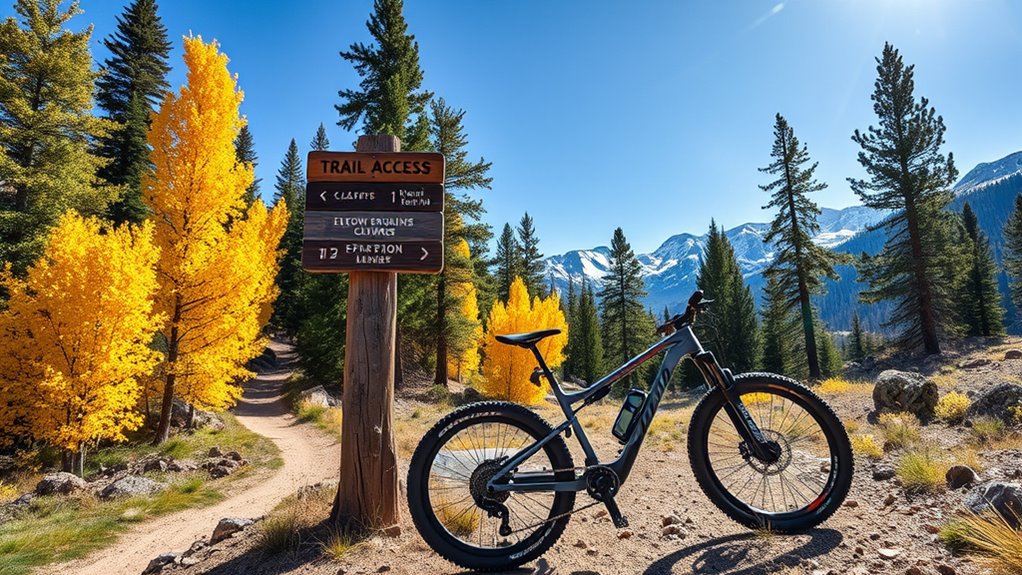
If you’re planning to ride an e-bike in Colorado, it’s important to understand the state’s laws that govern their use on roads and trails. E-bike safety is a top priority, and knowing the rules can help prevent accidents and ensure you stay compliant. Colorado categorizes e-bikes into three classes based on speed and pedal assistance: Class 1, Class 2, and Class 3. Class 1 and Class 2 e-bikes are generally allowed on most roads and bike paths, but Class 3 bikes, which can reach higher speeds, have more restrictions. You need to be aware of local regulations, especially when riding on trails, to avoid fines or confiscation of your e-bike.
Understanding Colorado’s e-bike classes helps you stay legal and safe on trails and roads.
Trail signage plays a crucial role in guiding e-bike riders through various terrains. When riding Colorado trails, always pay close attention to posted signage. Signage indicates whether e-bikes are permitted, restricted, or entirely prohibited on specific sections. Many trails are shared with hikers and horseback riders, so respecting trail signage ensures everyone’s safety. If signage indicates e-bikes are not allowed, you must respect these restrictions to avoid conflicts and potential legal issues. Conversely, when trails are open to e-bikes, adhere to posted speed limits and ride responsibly to reduce risks for yourself and others.
E-bike safety isn’t just about following laws; it’s also about riding defensively and wearing proper gear. Always wear a helmet, and consider additional safety equipment such as gloves and reflective clothing, especially if you’re riding during low-light conditions. Adjust your riding speed to suit trail conditions, and stay alert for trail signage that may warn of upcoming hazards or changes in trail access. Respect other trail users, give audible signals when passing, and remain vigilant for obstacles, loose gravel, or sudden turns. Additionally, be aware that surfing waves, especially large or dangerous ones, requires specialized skills and precautions, similar to how e-bike riders must understand trail conditions and signage for safe riding.
Colorado’s diverse landscapes mean you’ll encounter different trail types, each with its own rules and signage. Some areas might have designated e-bike zones, while others completely restrict motorized bikes. Always verify local regulations before heading out, and check trail signage for the most current access information. Keeping safety in mind and respecting signage helps preserve Colorado’s natural beauty and ensures you enjoy your ride responsibly. By understanding the laws and paying attention to trail signage, you’ll be better equipped to navigate Colorado’s scenic trails safely and legally.
Frequently Asked Questions
Are E-Bikes Allowed on Colorado Ski Resort Trails?
You can’t ride e-bikes on Colorado ski resort trails because trail access is usually restricted based on resort policies. Most ski resorts prohibit e-bikes to protect the environment and guarantee safety for all visitors. Always check the specific resort’s policies before attempting to ride, as trail access varies. Respecting ski resort rules helps maintain the natural beauty and safety standards for everyone enjoying the outdoors.
How Do Colorado E-Bike Laws Differ From Neighboring States?
Think of state regulations as a patchwork quilt—each state weaving its own rules. Colorado’s e-bike laws are more permissive, allowing e-bikes on many trails with fewer restrictions. In contrast, neighboring states often enforce stricter rules, limiting e-bike access to certain areas or class types. Enforcement differences also mean Colorado tends to be more lenient, making it easier for you to ride where you want.
Can I Ride an E-Bike on Colorado’s National Park Trails?
You can ride an e-bike on Colorado’s national park trails only if the park’s regulations permit it. Many national parks restrict e-bike access to protect natural resources, so check specific park rules before riding. Always stay on designated trails and respect trail access laws to avoid penalties. Remember, national park regulations vary, and some parks may prohibit e-bikes altogether, so research ahead to guarantee you’re compliant.
Are There Age Restrictions for E-Bike Riders in Colorado?
In Colorado, age restrictions for e-bike riders are generally set at 16 years old, aligning with licensing requirements for motorized vehicles. Over half of Colorado’s trail accidents involve riders under 18, highlighting the importance of age limits. You must be at least 16 to ride an e-bike legally, and some areas may require rider licensing or parental consent for minors. Always check local trail rules before riding.
Do E-Bike Laws Vary Between Urban and Rural Areas?
Yes, e-bike laws differ between urban and rural areas. In cities, urban regulations often require you to stay on designated bike lanes and follow specific speed limits. In rural areas, you typically have more rural access, allowing you to ride on trails and open roads without strict urban restrictions. Always check local rules before riding, as regulations can vary widely, ensuring you stay compliant and enjoy your ride safely.
Conclusion
So, here’s the irony: you now have all these rules to enjoy Colorado’s trails, yet staying within the law means you might actually have more freedom. Just remember, while you’re zooming around on your e-bike, the real challenge is keeping up with the ever-changing laws—because nothing says adventure like trying to decode legal jargon on the fly. But hey, at least you’ll be riding legally… and hopefully, having a blast while you’re at it.
